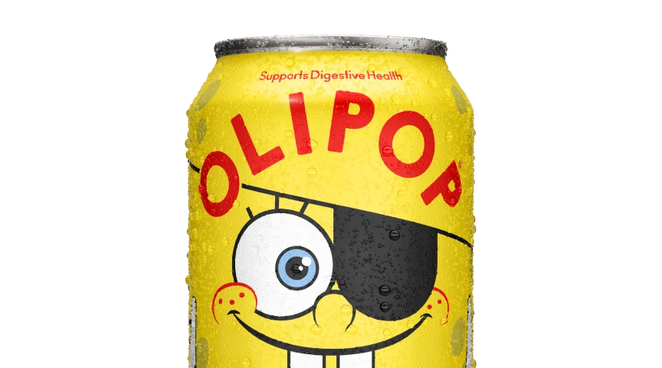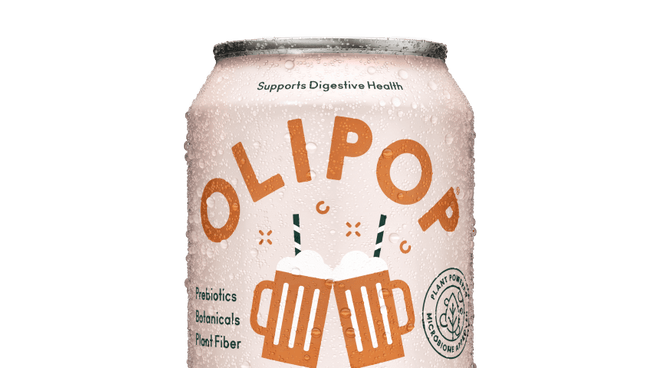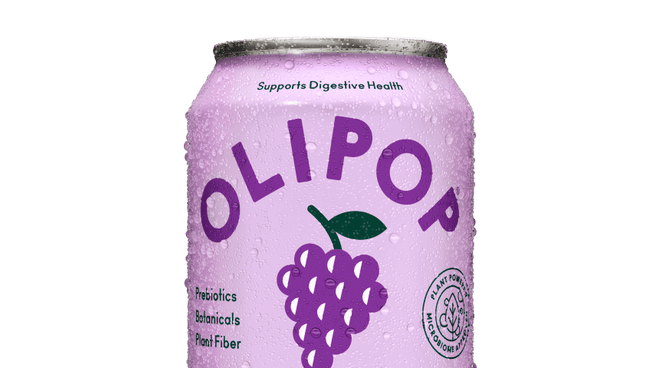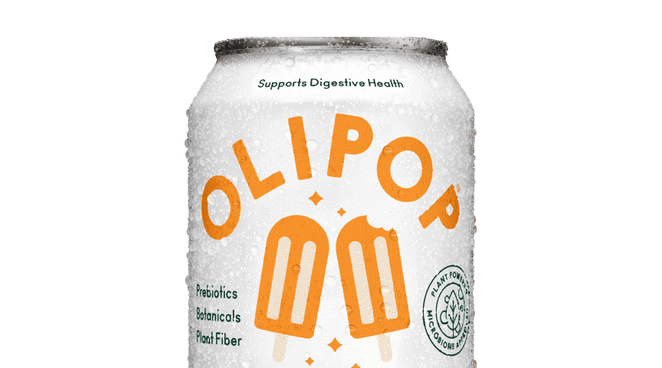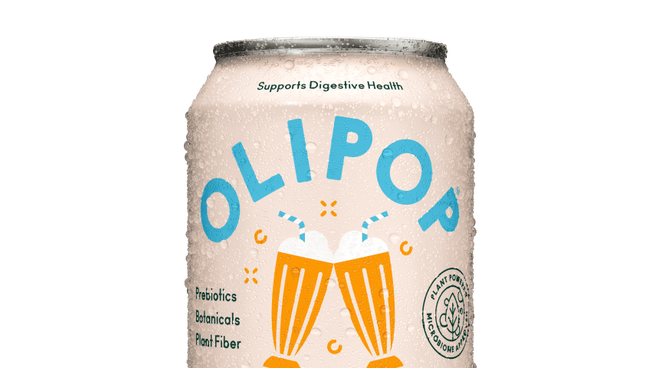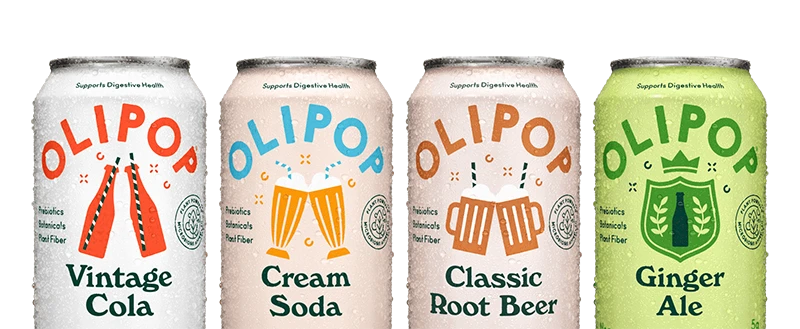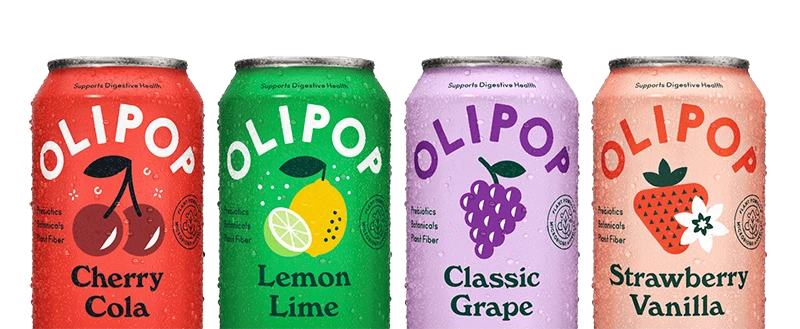It’s Earth Month, which means that sustainability is top of mind for a lot of us! Recycling stands out as a simple yet powerful way to contribute towards a healthier planet this month and beyond. But we get it, it’s not always easy to know what or how to recycle. Whether you're a hardcore eco-warrior or a recycling newbie, this blog's for you. We'll break down recycling into easy steps, share some tips, and show how simple changes can make a big difference for our planet. Plus we’ll share how we at OLIPOP are doing our part to work towards a more sustainable future. Let’s dive in…
Why Recycling Is Important
Recycling is the process of collecting, processing, and remanufacturing old or used materials into new products. It takes items that would otherwise sit in a landfill and gives them new life.[1] Recycling offers a ton of benefits not only for the environment but also for our economy and community:
- Reducing waste: Recycling helps limit the amount of waste sent to landfills or incinerators, which helps ease pressure on limited landfill space and minimizes pollution caused by waste disposal.[1]
- Conserve natural resources: By recycling, we can conserve natural resources like minerals, water, and timber while reducing energy consumption and environmental degradation.[1] [2]
- GHG and pollution reduction: Recycling reduces the need to extract, transport, and manufacture new raw materials, helping decrease greenhouse gas emissions that contribute to climate change.[2] According to the Environmental Protection Agency (EPA), recycling and composting helped save over 193 million metric tons of carbon dioxide in 2018, equivalent to the annual carbon emissions of over 42 million cars.[1] This significant savings underscores the powerful impact recycling can have on our planet.
- Reduces habitat destruction: Additionally, recycling helps protect biodiversity by reducing habitat destruction and preserves landscapes by minimizing the need for new landfills and incinerators.
- Economic opportunities: Recycling is a large industry involving collecting, processing, and manufacturing. This means it offers jobs and economic opportunities for the community.[2] According to a study done by the EPA in 2020, recycling helped account for over 681,000 jobs and $37.8 billion in wages in the United States in a single year.[1]
- Supports communities: Many waste management facilities exist in underserved communities, creating negative impacts on health, property values, land use, and more. Through recycling, we can reduce this impact by offering a more sustainable option.[1]
As you can see, recycling plays a pivotal role in conserving natural resources, saving energy, reducing pollution, and fostering economic growth. It's a key component of sustainable living and environmental protection efforts worldwide. But deciding to recycle is only the first step. Not everything can be recycled, so the next step is figuring out how to recycle correctly.[3] Let’s tackle that next.
How To Recycle
So, recycling is important! But how do you recycle and what’s key to keep in mind? Well, here are the basic recycling steps to follow:[4]
1. Identify what is recyclable: Only put recyclable materials in the recycling bin. This includes paper, cardboard, some plastics, aluminum, and other metal cans. We’ll dive into the specifics of each of those below!
2. Clean and empty: Before you throw, make sure your recyclables are empty and clean. Dirty items can get in the way of the recycling process.
3. Keep it loose: Don’t place your recyclable items in a bag, empty them loose in the bin.
4. Sort or single stream: Lastly, make sure to check your local guidelines to determine whether your area uses single-stream or if it requires you to sort out your recycling.
Recycling guidelines vary by location, so make sure to check in with your local recycling center for the most accurate information. Placing non-recyclable items in your recycling bin can contaminate or mess up the recycling process, so educating yourself on what you can and can’t recycle in your area is super important.
What’s Recyclable?
Speaking of educating yourself on what’s recyclable, let’s dive into a general overview of what you can and can’t recycle. But of course, remember to check with your local recycling center for specific guidelines for your location!
Plastics
Plastics are quite possibly the most confusing item to recycle, so we’ll start with them first. And that’s because not all plastic is recyclable. On the bottom of your plastic container, you’ll notice a number from one to seven featured inside a triangle of recycling arrows. This number indicates the type of plastic and the recyclability of that item. On the whole, hard plastics #1, #2, and #5 are typically recyclable.[5] These include:[6]
- Water and beverage bottles (keep the lid on the bottle, they’re too small to recycle on their own)
- Food jars and containers (like milk jugs, yogurt, or salad dressing containers)
- Cosmetic and household cleaner bottles (like detergent or mouthwash containers)
- Disposable plates and cups
- Plastic bags and #4 plastic shrink wrap (Many folks aren't aware that this type of plastic is, in fact, recyclable. Several municipal recycling programs accept it, and even if your local curbside doesn't, you can still recycle it at participating stores, like Safeway.)
Avoid placing these plastic items in your recycling bin:[5]
- Plastic foam
- Straws
- Utensils
- Bubble wrap
- Packing peanuts
- Plastic food wrappers
- Plastic without numbers
Depending on your area, you might be able to recycle other recycling numbers. But it’s important to check before you do to avoid possible contamination!
Unfortunately, most plastic ends up in landfills, or worse, in waterways that eventually flow into the ocean. According to the EPA, Americans generated over 35 million tons of plastic in 2018, yet only 8.7% was recycled.[3] According to a 2021 Beyond Plastics report, if the plastic industry was a country it would be the fifth largest emitter of greenhouse gasses in the world.[7] So the best thing you can do is limit the amount of plastic you’re using and recycle the plastic you can.
Metal & Aluminum Cans
All steel, tin, bi-metal, and aluminum food and beverage cans and containers are recyclable. This includes aluminum foil! Just remember to clean it before you place it in the recycling bin. There’s a reason why we use aluminum cans at OLIPOP, because, unlike plastic, aluminum is infinitely recyclable.[8] This means you can recycle and reuse aluminum cans over and over again. Thanks to aluminum’s infinite recycling potential, nearly 75% of all aluminum ever produced is still in use today. This saves 95% of the energy needed to mine new aluminum.[8]
However, while aluminum has a higher recycling rate than other products, these rates have fallen over 50% in the past few years.[8] So it’s important that we all do our part to recycle aluminum and keep this infinitely recyclable item in use.
Cardboard & Paper
Paper makes up over 20% of all trash generated each year, more than any other material.[3] And that waste can be avoided because most paper is recyclable! Check with your local guidelines for the most up-to-date list for your area, but on the whole here are paper items you should be able to recycle:[9] [10]
- Cardboard (like moving, shipping, and food boxes)
- Cardboard trays (like the ones we use at OLIPOP)
- Envelopes & folders
- Newspapers & magazines
- Paperback books
- Brochures, office paper, junk mail
- Notebook and scrap paper
- Shredded paper (collect it together in a paper bag before you recycle)
These paper products are not recyclable:
- Tissue paper
- Wrapping paper with embellishments (like metallic, glitter, or plastic)
- Paper towels and napkins
- Plastic-coated paper containers
- Paper products contaminated with food or liquid—like used paper plates, cups, and greasy pizza boxes for example (but they may be compostable! Check with your local guidelines first before you throw them in the bin.) [9]
Remove any staples, paper clips, or plastic from the paper before you recycle. Better yet, try and minimize your use of paper products in the first place!
Glass
Glass has a longer lifespan than many other packaging materials, such as single-use plastics. And like aluminum, it can be recycled and reused over and over again. However, according to the EPA, the United States has a very low glass recycling rate, recycling only 31% of the glass we use.[11] A big reason for this is that glass recycling isn’t available in all areas, so it’s important to check with your local recycling center before you throw it in the bin. If your area does accept glass recycling there are a few key things to keep in mind:[12]
- Brown, green, and clear glass bottles and jars are acceptable
- Keep the lid on your bottle or toss the lid in the trash, they’re too small to recycle on their own
- Rinse and clean your glass bottle or jar before you recycle it
- Avoiding tossing broken glass in the recycling bin
- Some areas require you to separate glass from plastic, so check your local guidelines
Items you can’t recycle
There are certain items you can’t place in your basic recycling bin like batteries, electronics, diapers, light bulbs, and so on. Some of these items, like batteries, you can recycle but only at specific recycling centers or locations. For example, some grocery stores accept plastic bags and batteries. There might also be specific E-waste collection locations near you for dropping off old electronics. Check with your local recycling center to figure out what your area does and doesn’t accept.
Where Does Your Recycling Go?
After tossing recyclables in your recycling bin, the next step on their journey is typically to a material recovery facility (MRF) for sorting and processing.[2] The MRF separates different types of materials, such as glass, paper, plastic, and metal, using various techniques such as manual sorting, magnets, screens, and optical scanners.[13] From there:
- Paper and cardboard head to paper mills for pulping and transformation into new products.
- Plastic is melted down into pellets to create fresh plastic items.
- Glass is cleaned, crushed, and remolded into new glass goods.
- Metals, like aluminum, are melted down to craft new metal pieces.
The exact journey and final destination varies on your location and the local infrastructure in place. For example, take a look at this PBS video that explains how Las Vegas uses their recycling and landfills to help power their community:
Recycling Challenges
As much as recycling has its benefits, there are also significant challenges to the current system we have in place that we’d be remiss not to mention:
- Lack of education: Most Americans want to recycle but face challenges on exactly how to do it. This often results in recycling ending up in the trash and trash in recycling. This creates issues downstream, and in many cases, causes contamination that negates the entire process.[1]
- Poor infrastructure: But it’s not all on the individual! The recycling infrastructure set up today just isn’t built for the amount of trash we’re producing. There are ways we could better manage this process from production to collection to manufacturing.[2]
- Poor product & packaging design: Speaking of production, a big issue we’re facing in the recycling industry is that we’re creating too much waste. It’s not just about recycling, but limiting the amount of stuff we need to recycle in the first place. We need more efforts in place to replace single-use plastics with recycled or compostable materials and for businesses to consider sustainability in their product and packaging decisions.[2]
- Low recycling rate: Thanks to poor recycling infrastructure, lack of access and education, and the overabundance of recyclables we have low recycling rates in America. It’s estimated that Americans throw over 76% of all recyclables in the trash.[14]
- International exports: Historically, the U.S. exports a lot of our recycling internationally. Not only are there moral and ethical considerations surrounding this, but changing international policies have shifted how much we can export. This has forced us to consider a more domestic approach, but as we mentioned in the “infrastructure” bullet, this isn’t exactly a strength.[2]
Even with these challenges in place, hope isn’t lost for recycling. There are steps we can take to help. At OLIPOP, we’re determined to be a part of the change. And as an individual, there are steps you can take to help increase recycling rates. Let’s talk about those next!
OLIPOP’s Approach to Sustainability and Recycling
At OLIPOP, we're on a mission to be more aware, do better, and make a positive impact socially, economically, and environmentally. Part of this commitment to sustainability is thinking about the impact our product and our supply chain have on the environment. That’s why we’re working to improve the sustainability of our packaging by increasing the amount of recycled content we use. Here’s how we’re doing that:
- Aluminum cans: We selected aluminum as our product’s packaging because of its sustainability. GHG emissions associated with aluminum cans are the lowest they can be for a single-use carbonated beverage. Plus, as we’ve mentioned, aluminum is infinitely recyclable!
- How2Recycle labeling: We’re implementing How2Recycle labels on our packaging for clear recycling instructions. These labels provide consistent and transparent on-package disposal instructions, making recycling even easier.
- Supply Chain Transparency: We engage our suppliers on sustainability through annual surveys and shared resources, fostering ongoing dialogue and opportunities for improvement.
- Education: We feel it's our responsibility to not only increase our recycling rates but also encourage recycling in our community through better labeling and education. One way we do that is through articles like this one to help you recycle more effectively!
- Cardboard packaging: We're increasing our use of recycled content and continuing to reduce material use through packaging optimizations.
How to Recycle: The Takeaway
Recycling doesn’t have to be difficult, but it does take a little know-how to get it right. The key is to identify what your local area can recycle, know where to drop off your items, and then wash off any food or residue before you throw them in the bin. We also encourage you to think about ways you can use less paper and plastic in your everyday life to help cut back on the amount of waste you produce. For more ideas on ways you can take action this Earth Month and beyond make sure to check out our blog Embracing Sustainability: 7 Achievable Steps for a Healthier Planet and Lifestyle. Thanks for joining us in making the world a little greener this Earth Month!
Resources and Tools for Effective Recycling
Before you go, here are some helpful resources and tools we recommend to make sustainability and recycling that much easier:
- Earth911 Recycling Search: Locate your nearest recycling center using one of North America's most extensive recycling databases.
- Earth911 Recycling Guidelines: Have something to recycle? Find out how and where with Earth911’s extensive recycling guidelines.
- Individual Waste Reduction Model (iWARM) Tool: This nifty downloadable tool helps identify how much energy you’re saving by recycling small quantities of common waste materials.
- TerraCycle's Recycling Programs: TerraCycle offers free and paid recycling programs for hard-to-recycle items, which could be especially useful for items not accepted in standard recycling programs.
Sources
- Recycling Basics and Benefits. (2023, November 27). United States Environmental Protection Agency (EPA). https://www.epa.gov/recycle/recycling-basics-and-benefits
- The U.S. Recycling System. (2024, February 21). United States Environmental Protection Agency (EPA). https://www.epa.gov/circulareconomy/us-recycling-system
- How Do I Recycle Common Recyclables. (2023, December 1). United States Environmental Protection Agency. https://www.epa.gov/recycle/how-do-i-recycle-common-recyclables
- You + Our Recycling Services = A More Sustainable Tomorrow. (n.d.). Republic Services. https://www.republicservices.com/residents/recycling-and-solid-waste/recycling-basics
- Plastic Recycling. (n.d.). Republic Services. https://www.republicservices.com/residents/recycling-and-solid-waste/plastic
- Types of plastic - A complete plastic numbers guide. (2020, January 17). YesStraws. https://yesstraws.com/blogs/news/types-of-plastic-plastic-numbers-guide
- The New Coal: Plastics and Climate Change. (2021, October). Beyond Plastics. https://www.beyondplastics.org/plastics-and-climate
- Infinitely Recyclable. (2021). Aluminum Association. https://www.aluminum.org/Recycling
- Cardboard Recycling. (n.d.). Republic Services. https://www.republicservices.com/residents/recycling-and-solid-waste/cardboard
- Paper Recycling. (n.d.). Republic Services. https://www.republicservices.com/residents/recycling-and-solid-waste/paper
- Glass: Material-Specific Data. (2022, December 3). United States Environmental Protection Agency. https://www.epa.gov/facts-and-figures-about-materials-waste-and-recycling/glass-material-specific-data
- Glass Recycling. (n.d.). Republic Services. https://www.republicservices.com/residents/recycling-and-solid-waste/glass
- Metal and Aluminum Recycling. (n.d.). Republic Services. https://www.republicservices.com/residents/recycling-and-solid-waste/metal-and-aluminum
- Kaufman, L. (2024, January 10). Americans Throw 76% of Their Recyclables Into the Trash. Bloomberg. https://www.bloomberg.com/news/articles/2024-01-10/americans-trash-three-quarters-of-recyclables-study-finds
- Recycling is the process of collecting, processing, and remanufacturing old or used materials into new products. It offers a ton of benefits for the environment, economy, and community.
- You can recycle some plastics, aluminum and metal cans, cardboard and paper, and glass.
- First identify what your local area can recycle, then know where to drop off your items, and lastly, wash off any food or residue before you throw them in the bin.








